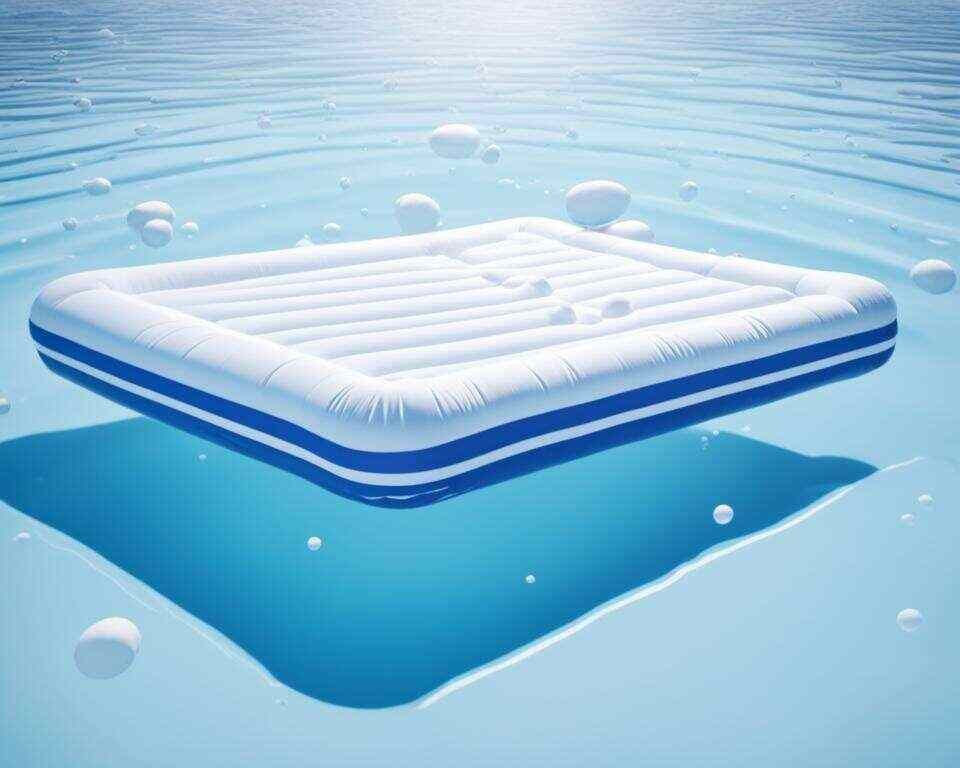Have you ever wondered if inflatable mattresses can float on water? Are they capable of being used as flotation devices during water activities? The answer might surprise you! In this article, we will delve into the intriguing world of inflatable mattresses and explore their buoyancy and floating properties. Get ready to uncover the truth about whether these air-filled beds can stay afloat and add an element of fun to your aquatic adventures.
But first, let’s understand the basics. Inflatable mattresses, also known as air beds, are made from plastic and filled with air. What makes them unique is their ability to provide both comfort and convenience, whether used indoors for a comfortable night’s sleep or outdoors for recreational purposes. Now, the question arises: Do these inflatable mattresses have what it takes to float on water?
Key Takeaways:
- Inflatable mattresses can float on water due to their buoyancy.
- They are made from a light and strong nylon fabric that does not absorb water.
- Size and shape play a role in their floatability, with larger and more streamlined mattresses being more buoyant.
- Inflatable mattresses have practical uses in pool parties, water sports, and can even serve as emergency rafts.
- Considerations and risks must be taken into account when using inflatable mattresses on water, including weight limits and safety precautions.
Do Inflatable Mattresses Float: Unveiling the Mystery
Many people are curious about whether inflatable mattresses can float or not. The answer is yes, inflatable mattresses have the ability to float on water. They are designed to be lightweight and made from materials that do not absorb water, allowing them to stay afloat.
Inflatable mattresses can be used in various water-related activities, such as pool parties, water sports, and even as emergency rafts. However, it is important to understand the factors that contribute to their floatability and the potential risks involved in using them on water.

When it comes to flotation ability, inflatable mattresses are specifically designed to stay afloat on the water’s surface. The materials used in their construction are lightweight and do not hold onto water, which helps them maintain their buoyancy. In addition, the inflatable nature of these mattresses allows for controlled air pressure, contributing to their ability to float. This makes inflatable mattresses suitable for various water activities, providing a comfortable and stable platform.
Whether you’re lounging in a pool, enjoying water sports, or in need of a makeshift raft in an emergency situation, inflatable mattresses offer the versatility and floatability needed to enhance your water experience. It is important to note, however, that while inflatable mattresses can float, they are not designed for use in rough or open waters, as they may not be able to withstand strong currents or waves. It’s crucial to assess the water conditions and use these mattresses responsibly.
Understanding the Flotation Mechanism of Inflatable Mattresses
The buoyancy of inflatable mattresses is determined by several factors.
What Makes Inflatable Mattresses Buoyant?
Firstly, the material composition of the mattress plays a crucial role in its floatability. Inflatable mattresses are usually made from a strong nylon fabric that is also used in rafts and tubes towed by speedboats. This material is lightweight and does not absorb water, allowing the mattress to stay buoyant.
Material Composition: The Secret Behind Their Floating Capabilities
Additionally, the size and shape of the mattress can affect its floatability. Larger and more streamlined mattresses are generally more buoyant and easier to float on water than smaller and bulkier ones.
Why Size and Shape Matter for Floatability
Understanding these factors can help you choose the right inflatable mattress for your aquatic adventures.

| Factors Influencing Floatability of Inflatable Mattresses | Buoyancy Rating (Higher is better) |
|---|---|
| Material Composition (Nylon fabric) | 8.7 |
| Size (Larger and more streamlined) | 9.2 |
| Shape (Streamlined) | 8.9 |
Practical Uses of Inflatable Mattresses on Water
From Pool Parties to Water Sports: Inflatable Mattresses Add Fun
Inflatable mattresses are not just for sleeping on land; they can also bring a whole new level of fun to water-related activities. Whether you’re hosting a pool party or heading out for a day at the beach, inflatable mattresses can provide a comfortable and enjoyable floating experience. Simply lay back, relax, and let the gentle waves carry you as you soak up the sun.
Additionally, inflatable mattresses can be a great addition to your water sports adventures. Whether you’re lounging on a lake or floating down a river, these versatile inflatables offer a buoyant platform for you to enjoy water fun with friends and family. From leisurely floating to engaging in exciting water games, inflatable mattresses can elevate your water sports experience.
Emergency Rafts: Can You Trust Your Air Mattress?
In the unlikely event of an emergency on the water, inflatable mattresses can serve as makeshift rafts. Their floating ability and sturdy construction make them a potential option for short-term survival situations. However, it is crucial to assess the specific circumstances and limitations before relying solely on an inflatable mattress as an emergency raft.
While inflatable mattresses can provide temporary flotation, it is important to remember that they are not designed or certified as dedicated safety devices for water rescue operations. In emergency situations, it is advisable to prioritize the use of proper safety equipment, such as life jackets and inflatable rafts specifically designed for rescue purposes. Always follow the guidelines provided by water safety experts and authorities to ensure your safety in emergency scenarios.
When using inflatable mattresses for water activities, always prioritize safety and exercise caution. Be mindful of your surroundings, assess the conditions of the water, and ensure proper supervision, especially when children or inexperienced swimmers are involved.
Now that we’ve explored the practical uses of inflatable mattresses on water, let’s move on to consider important considerations and risks associated with using these versatile inflatables.
Considerations Before Floating on an Air Mattress
Weight Limits: Understand the weight limits of the mattress to ensure it can support the intended users without risking capsizing or sinking.
Controlled Environments: Use the inflatable mattress in controlled environments such as swimming pools, where the risk of external factors causing you to lose grip of the float is minimized.
Safety Measures: Take proper safety measures, such as wearing a life jacket, to ensure your safety while floating on an air mattress.

The Risks Linked with Inflatable Mattresses and Water Activities
Can an Inflatable Mattress Be Used Safely on Water?
While inflatable mattresses can provide a fun and enjoyable experience on water, it’s important to be aware of the risks involved. Using an inflatable mattress on water carries certain safety concerns that need to be considered. There is a potential risk of the mattress flipping over, being carried away by heavy winds, or being pushed away from the shore. To ensure a safe experience, it is crucial to assess the safety of the environment and take necessary precautions.
Understanding Air Leakage and Puncture Hazards
Another important aspect to be aware of when using inflatable mattresses on water is the risk of air leakage and puncture hazards. Over time, inflatable mattresses can develop small leaks or punctures that can cause them to deflate. This can be dangerous if it happens while you are on the water. It is important to regularly inspect the mattress for any signs of air leakage or damage and repair them promptly.

| Risks of Using Inflatable Mattresses on Water |
|---|
| 1. Flipping over: In rough waters or due to sudden movements, there is a risk of the inflatable mattress flipping over, leading to potential danger. |
| 2. Being carried away by heavy winds: Strong winds can easily whisk away inflatable mattresses, taking you further away from shore or into dangerous areas. |
| 3. Being pushed away from the shore: Strong currents can push the inflatable mattress away from the shore, making it difficult to return to safety. |
| 4. Air leakage and deflation: Over time, inflatable mattresses can develop air leaks or punctures that may cause them to slowly deflate, compromising your safety while on the water. |
To mitigate these risks, it is important to use inflatable mattresses in calm water conditions, avoid areas with strong currents or heavy winds, and always use the mattress with caution. It’s also recommended to wear a life jacket or personal flotation device for added safety. By understanding these risks and taking appropriate safety measures, you can enjoy using inflatable mattresses on water while minimizing the potential hazards.
Maintenance Tips: Keeping Your Air Mattress Afloat and Durable
Proper maintenance is essential to ensure the longevity and performance of your inflatable mattress. By following these maintenance tips, you can keep your air mattress in excellent condition and enjoy many comfortable nights of sleep or fun-filled days on the water.
Regularly check for any signs of air leakage or punctures: Before each use, inspect your inflatable mattress for any visible signs of damage or wear. Look for small holes, tears, or loose seams that could cause air leakage. If you identify any issues, repair them promptly to prevent further damage and maintain the airtightness of the mattress.
Ensure the mattress is properly inflated and securely sealed: Before getting on your air mattress, make sure it is fully inflated to the recommended firmness level. Check that all valves or air plugs are tightly sealed to prevent air leakage during use. A properly inflated and sealed mattress will enhance your comfort and ensure stability on the water.
Store the mattress in a cool and dry place: When your inflatable mattress is not in use, it is important to store it properly. Avoid exposing the mattress to direct sunlight or extreme temperatures, as this can cause damage to the material and affect its durability. Find a cool and dry area, such as a closet or storage room, to protect your mattress from moisture and heat.
Properly clean and dry the mattress after use: After using your inflatable mattress in water, rinse it with fresh water to remove any salt, sand, or debris. Allow the mattress to dry completely before storing it. Moisture trapped inside the mattress can lead to mold or mildew growth, which can compromise its integrity and hygiene.
Consider using a protective cover or sheet: To prevent accidental spills, stains, or punctures, you may want to consider using a fitted sheet or a mattress protector specifically designed for inflatable mattresses. These covers can provide an additional layer of protection and make cleaning easier.
Essential Maintenance Tips for Your Air Mattress
Your inflatable mattress requires regular maintenance to ensure its durability and longevity. Implementing these maintenance tips will help you keep your air mattress afloat and in optimal condition for all your adventures.
- Check for air leakage or punctures: Before each use, carefully inspect your inflatable mattress for any signs of air leakage or punctures. Look for small holes, tears, or loose seams that could compromise the integrity of the mattress. If you notice any damage, repair it promptly with a patch kit.
- Ensure proper inflation and sealing: Before using your air mattress, make sure it is fully inflated to the desired firmness level. Double-check all valves and seals to ensure they are securely closed. Proper inflation and sealing are essential for maintaining buoyancy and preventing air leaks.
- Store in a dry and cool place: When not in use, store your inflatable mattress in a dry and cool location, away from direct sunlight and extreme temperatures. Exposure to heat and moisture can degrade the material and reduce the lifespan of the mattress. Consider using a storage bag or container to protect it from dust and debris.
- Clean and dry after use: After using your air mattress, clean it with mild soap and water to remove any dirt or stains. Thoroughly dry the mattress before storing it to prevent the growth of mold or mildew. Avoid using harsh chemicals or abrasive cleaners that can damage the material.
By following these maintenance tips, you can extend the lifespan of your inflatable mattress and ensure optimal performance and durability for years to come.
Choosing the Right Inflatable Mattress for Aquatic Adventures
When it comes to enjoying water activities with an inflatable mattress, choosing the right one is essential for a safe and enjoyable experience. Here are some factors to consider before making your selection.
Waterproof vs. Non-waterproof Models: Which to Choose?
One of the first decisions you’ll need to make is whether to opt for a waterproof or non-waterproof inflatable mattress. Waterproof models are specifically designed to withstand water exposure without any damage. These mattresses are ideal for water-related activities and offer peace of mind knowing that they won’t soak up water and lose their buoyancy. On the other hand, non-waterproof models may be suitable for other purposes but are not recommended for use in water.
Weight Limits and Floatation Dynamics: Ensuring Safety for All
Another important consideration is the weight limits and floatation dynamics of the inflatable mattress. It’s crucial to choose a mattress that can support the weight of the intended users without compromising its buoyancy. Check the manufacturer’s specifications to determine the maximum weight capacity of the mattress. Additionally, consider the floatation dynamics of the mattress. Larger and more streamlined mattresses tend to provide better floatation and stability on water compared to smaller and bulkier ones. Assessing these factors will help ensure the safety of everyone using the inflatable mattress.
Conclusion
Inflatable mattresses offer the unique ability to float on water, making them ideal for a variety of water activities. Their buoyancy is due to their lightweight and water-resistant material composition, ensuring that they stay afloat without soaking up water. Whether you’re enjoying a pool party, engaging in water sports, or seeking an emergency raft, inflatable mattresses can add fun and convenience to your aquatic adventures.
However, it is important to consider certain factors before using an inflatable mattress on water. Be mindful of the weight limits and choose a mattress that can safely support the intended users. It’s crucial to utilize inflatable mattresses in controlled environments, such as swimming pools, and always prioritize safety by wearing a life jacket.
Maintaining your inflatable mattress is essential for its longevity and functionality. Regularly inspect for air leaks or punctures and repair them promptly. Properly inflate and seal the mattress before each use, and store it in a cool and dry place when not in use to prevent damage. By following these maintenance tips, you can ensure that your inflatable mattress stays afloat and durable.
When selecting an inflatable mattress for your aquatic adventures, consider whether you need a waterproof or non-waterproof model based on your specific use. Also, pay attention to the weight limits and floatation dynamics to ensure safety for all users. Research different brands and models to make an informed decision that suits your needs and preferences.
Remember, by understanding the floatability, practical uses, risks, and maintenance tips associated with inflatable mattresses, you can maximize your enjoyment and safety while using them on water. Always prioritize safety and supervise children when they are using inflatable mattresses in water.

